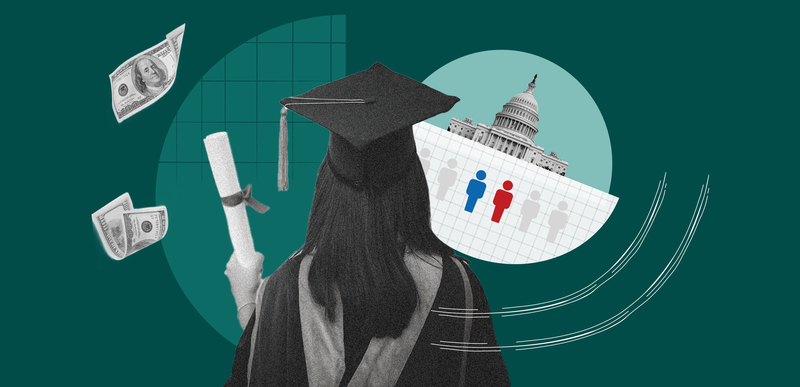Americans Are United On Accountability
Assessing Legislative Gains and Future Reforms
Blog Post

Natalya Brill/New America
Nov. 4, 2025
This blog post is the third in a series of blog posts diving deeper into the Varying Degrees 2025 data. Click here to read the first blog about state investment in higher education and here for the second blog about student support services.
Americans want and deserve a higher education that leads them to economic mobility and financial well-being, but many programs now leave students burdened with debt and no improved job opportunities, eroding public trust in the system. The One Big Beautiful Bill Act (OBBBA), which President Donald Trump signed into law earlier this year, drastically alters the U.S. higher education system. Changes in OBBBA include creating a new accountability metric that holds degree programs accountable for increased earnings after completion. The new accountability standard is designed to protect students and taxpayers alike and is a great step forward in addressing programs that don’t pay off, yet still more needs to be done.
The OBBBA Accountability Framework
The accountability framework, which Senate Republicans coined "Do No Harm," requires colleges and universities to provide data on how much their students earn after graduation. The framework compares undergraduate students’ earnings to those with a high school degree, and graduate students’ earnings to bachelor’s degree recipients in the same field. Programs that don’t meet this benchmark risk losing access to federal student loans.
Most Americans support this type of accountability for colleges. According to this year’s Varying Degrees, New America’s nationally representative survey gauging public opinion of higher education, 68 percent of Americans believe that programs with high rates of graduates earning less than the average high school graduate should lose tax dollars. [1] This finding has bipartisan support, with 64 percent of Democrats and 74 percent of Republicans in agreement (see Figure 1).
What Is Missing From the OBBBA Framework
Despite being a good step toward accountability, the OBBBA framework doesn’t fully address poor student outcomes and is missing some critical guardrails. The OBBBA framework removes failing programs’ access to loans, but it leaves their access to Pell Grants and other forms of federal aid intact.
And though OBBBA tries to address programs that lead to low earnings, it doesn’t sanction programs that meet the pay threshold but still leave students debt riddled. A debt-to-earnings metric, which evaluates graduates’ yearly student loan costs relative to their annual earnings, would help prevent students from taking on too much debt for programs that don’t offer financial stability after they graduate. Programs that continually drive up student debt with little return should lose federal financial aid, just like programs with poor earnings outcomes. There is bipartisan agreement for strengthening accountability for programs with high debt-to earnings ratios. A finding from Varying Degrees shows that 66 percent of the public, which includes 73 percent of Republicans and 61 percent of Democrats, agrees that colleges and universities should lose access to tax dollars if their students have high debt relative to their earnings (see Figure 2).
Perhaps the most egregious omission is that this framework does not apply to undergraduate certificate programs. Undergraduate certificate programs typically lead to the lowest pay outs for students, leaving many in debt without jobs that pay the bills. A new analysis by the Postsecondary Education and Economics Research (PEER) Center at American University found that only 3.7 percent of students attend programs which would fail the OBBBA accountability measure. However, among the students enrolled in low earnings programs, 52 percent of those students are enrolled in undergraduate certificate programs.
Another PEER Center analysis shows nearly one in four undergraduate certificate students who are receiving financial aid earn less than their high school degree counterparts and are more likely to default on their loans than those in other postsecondary programs. Not including undergraduate certificate programs is a major flaw in this accountability metric for students and families.
What Can Be Done?
The current Gainful Employment (GE) rule, a regulation finalized during the Biden administration which was slated to take effect last year, addresses these issues that OBBBA overlooks. GE applies to all vocational programs at both public and private, non-profit and for-profit institutions which participate in the federal aid programs, requiring that these programs either leave students with an affordable debt level or an earning premium compared to those with only high school diplomas or risk losing access to federal aid dollars. While only applying to a specific subset of programs, GE’s metrics complement the accountability guardrails in the “Do No Harm” standard.
Additionally, GE requires that all programs that receive federal financial aid (not only vocational programs) report data on enrollment, program costs, financial aid, and student outcomes. The measure, called Financial Value Transparency, provides crucial information to help students and families identify high-quality programs that meet their needs. Americans overwhelmingly support greater access to data on key quality indicators. When asked in Varying Degrees 2025 how important it is for colleges and universities to provide publicly available data on key indicators of quality, such as graduation rates, graduates’ employment rates, and earnings, 93 percent of Americans agree, including 96 percent of Democrats and 93 percent of Republicans (see Figure 3). And the support for greater data transparency has remained consistent since 2019.
GE could be subject to changes or elimination in the upcoming negotiated rulemaking in December. Considering the strong accountability metrics GE applies for vocational programs, the Department should preserve the regulation and determine how it can supplement the new “Do No Harm” standard to improve quality and make sure higher education creates better value for students and families.
____________________________________________________________________________________________
[1] Varying Degrees 2025 surveyed 1,631 American adults using NORC’s AmeriSpeak Panel. The final sample is inclusive of oversamples of African Americans, Asian/Pacific Islander Americans, and Hispanic Americans, and the findings have a margin of error of ±3.23 percentage points.